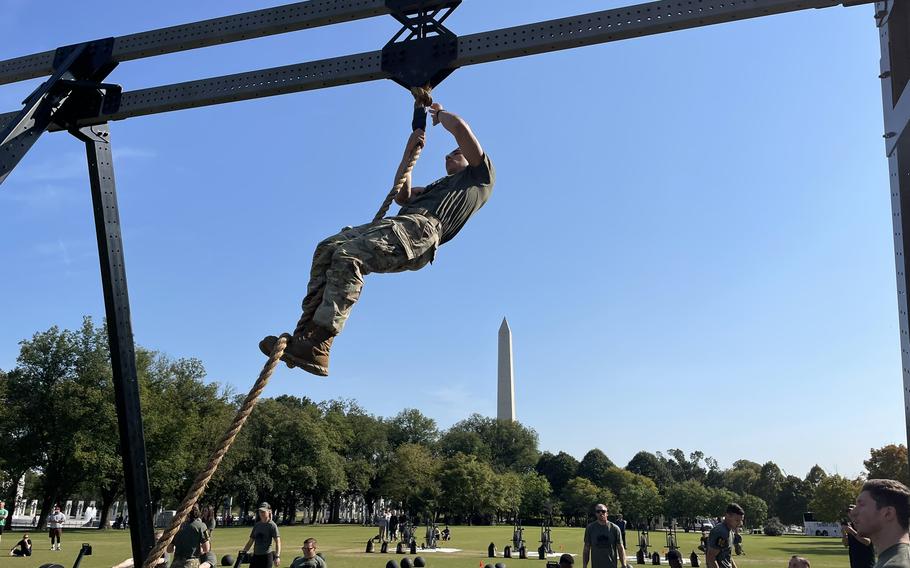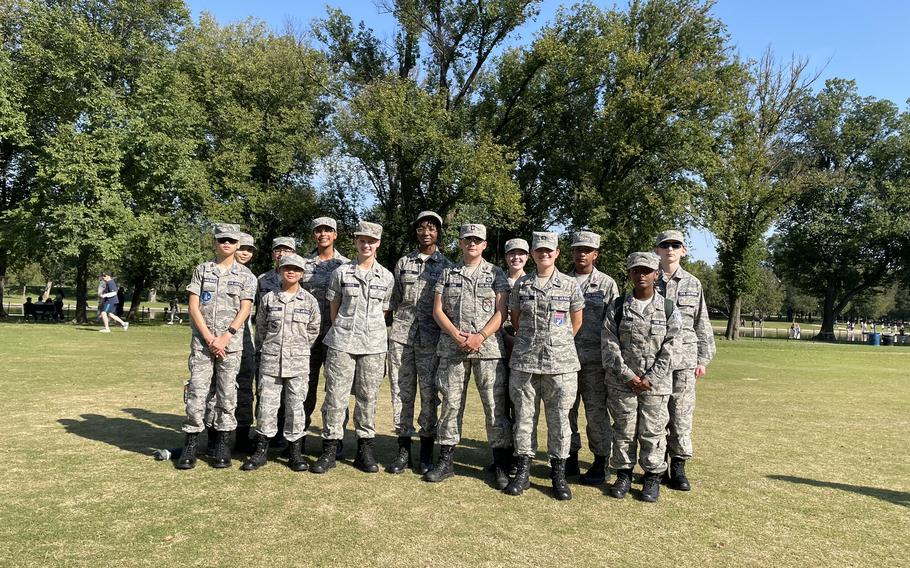
A soldier climbs a rope during the Army Best Squad Fitness Event in Washington, D.C., Oct. 12, 2024. (Alexander Banerjee/Stars and Stripes)
WASHINGTON — A few dozen U.S. Army soldiers worked up a sweat Saturday morning at the National Mall for one of the last events in the 2024 Best Squad Competition.
The competition began Sept. 29 and ran until Monday.
Soldiers competed within their commands until 12 squads formed, each representing a command’s top five competitors. Every squad consisted of a squad leader, team leader and three squad members.
The bulk of the competition took place at Fort Liberty in North Carolina, where soldiers conducted a land navigation challenge, practiced in weapons lanes and marched for 12 miles, among other things.
The event Saturday in the nation’s capital saw teams face off over fitness events that tested their strength, endurance and group coordination. The top four squads were then tested on their knowledge and professionalism. This year’s winning squad represented U.S. Army Pacific Command.
A revamped competition
This year’s event was the third since the competition had been renamed. From 2002 to 2021, the event was called the Best Warrior Competition, with participants aiming to win the Soldier of the Year or NCO of the Year awards.
The latest iterations still feature those awards, but the centerpiece since 2022 has become the title of Best Squad. Organizers hope it will promote cohesiveness.
Command Sgt. Maj. Christopher L. Mullinax said he hoped the event would be “unforgettable” and that participants would take what they learned back to their formations. While occasionally squads are filled with uniquely skilled players, it is usually strong teamwork that makes teams successful in the games, he said.
When asked if the Best Soldier and Best NCO prizes deterred players from working collectively, Mullinax said he suspected most participants forgot about those awards because they were so focused on the team effort.
Commander Sgt. Maj. Amara Fofana said that the name change was not merely cosmetic, because the competition became more challenging. He added that this year’s trials were tougher than in 2023, and the trend would probably continue next year.
Competitors could be future leaders of the Army, Fofana said, so it is important that they build relationships across the commands.
This was the first year that part of the competition took place in Washington, something underscored by both Mullinax and Fofana. Both hoped next year’s event would also take place at the Mall.
This is only the second year that the competition has had a community event, Mullinax said, and Saturday was specifically about “bringing Army to the community.” Between the dedicated audience and the curious looks of passers-by, Mullinax believed hundreds of people would end up seeing the event.
Trailblazing competitors
Spc. Isabella DiNonno of the 11th squad, representing U.S. Army Medical Command, was the only woman in the competition. DiNonno said her peers were very supportive of her joining the competition — in fact, they invited her to.
DiNonno also said that her squad has excellent teamwork skills because of their medical backgrounds. Teamwork is a necessity in hospital settings, especially when there are staff shortages, DiNonno said.
Another outlier was present: the sixth squad, representing U.S. Army Reserve. While squads in the competition are often composed of members from different parts of their command, every member of the sixth squad came from the same brigade in Puerto Rico, a first in the competition.
Staff Sgt. Nelson Medina, the squad leader, applauded his team, saying they fought expectations to get to the final event. He said he was proud to represent three things: Puerto Rico, Hispanic people, and the U.S. Army.
A small, but loyal audience
There were only a few dozen spectators at most — seemingly outnumbered by the number of competitors — but they made up for it with enthusiasm. Most stayed from beginning to end, on their feet for about three hours.
One competitor’s parents were in attendance. The mother and father of Sgt. Gary Henderson of the ninth squad, representing Special Operations Command, came to Washington from the Lansing, Mich., area to see their son compete.
The competition meant a lot to the elder Hendersons, who are unable to communicate frequently with their son. Social media posts about the games were “like a lifeline for us,” said Beverly Henderson, the competitor’s mother.
The family was reunited shortly before the event, and the parents got to meet the rest of their son’s squad as well. Their son’s teammates felt almost like family, Beverly said.
The audience also included a group of Civil Air Patrol cadets. Cadets in the U.S. Air Force civilian auxiliary program range from the ages of 12 to 18. The young volunteers were at the National Mall for a different obligation, but wandered over to watch the soldiers compete and stayed for most of the competition.

A group of Civil Air Patrol cadets that happened to be at the National Mall and watched the Army Best Squad Competition on Oct. 12, 2024. Cadets in the U.S. Air Force civilian auxiliary program range from the ages of 12 to 18. (Alexander Banerjee/Stars and Stripes)